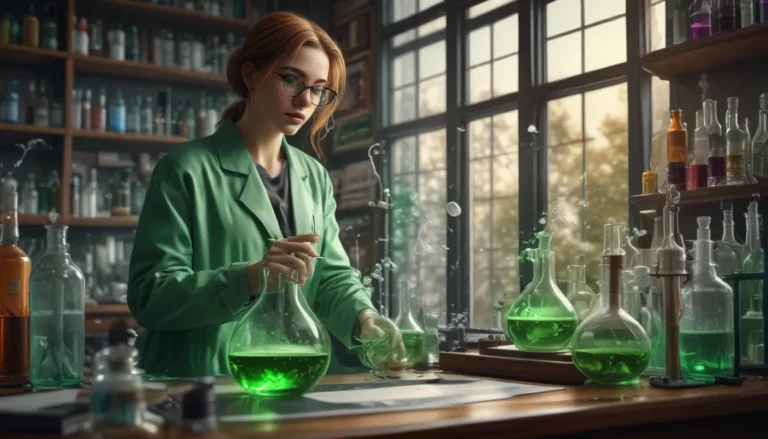A Note About Images: The images used in our articles are for illustration purposes only and may not exactly match the content. They are meant to engage readers, but the text should be relied upon for accurate information.
Ether – a captivating substance that has intrigued scientists and chemists for generations, holds a significant place in the realm of chemistry with its unique properties and various applications. From its ancient discovery to its modern-day utilization in industries and laboratories, ether stands out as a remarkable compound filled with intriguing facts that are bound to spark your curiosity. In this comprehensive article, we will embark on a fascinating journey through the world of ether, unraveling 13 extraordinary facts that will not only enhance your knowledge but also leave you in awe of this enigmatic chemical. So, buckle up and prepare yourself to delve deep into the captivating realm of ether!
The Origins of Ether: From Discovery to Significance
Ether, also known as diethyl ether or simply ether, made its debut in 1540 when a German-Dutch chemist named Valerius Cordus accidentally stumbled upon it while experimenting with other chemical compounds. This chance discovery laid the foundation for the profound impact ether would have in various fields, particularly medicine. Revolutionizing the world of anesthesia, ether became the first general anesthetic, enabling painless surgeries and intricate medical procedures. Additionally, its influence extended beyond medicine, leaving a mark in art, chemistry, and even photography. However, despite its versatile applications, caution is essential due to its potential environmental impact.
The Transformative Role of Ether in Anesthesia
One of the most pivotal uses of ether lies in its role as a general anesthetic. In the mid-19th century, American physician Crawford Long pioneered the use of ether for surgical purposes, marking a significant milestone in medical history. By administering ether to patients, surgeons were empowered to conduct complex procedures without causing discomfort or pain, revolutionizing the world of medicine. This groundbreaking application of ether paved the way for advancements in surgical techniques and patient care, making it an indispensable tool in the healthcare industry.
Exploring the Chemical Properties of Ether
Ether, characterized as a volatile and highly flammable liquid with a sweet, fruity aroma, boasts a chemical formula of (C2H5)2O, comprising two ethyl groups bonded to an oxygen atom. Widely utilized as a solvent across various industries, ether’s chemical composition and properties make it a versatile and valuable component in numerous applications.
Diving into Ether’s Historical Significance
During the late 19th and early 20th centuries, ether enjoyed widespread popularity as a recreational drug, renowned for its mind-altering effects. Particularly favored by artists and writers seeking inspiration and creative stimulation, ether carved a unique niche in the cultural landscape of the time, reflecting its intriguing allure beyond its scientific utility.
Ether’s Potential as a Combustible Fuel
With its high energy content, ether emerged as a promising candidate for a substitute to gasoline in the early 20th century. Various engines were designed to run on ether fuel, exploring its potential as an alternative energy source. However, safety concerns and the development of more efficient alternatives curtailed its widespread adoption, highlighting the complexities of transitioning to new fuel technologies.
Tracing Ether’s Influence on Early Photography
Ether played a pivotal role in the evolution of early photography, serving as a vital solvent in the preparation of collodion, a light-sensitive material used in the wet plate process. This instrumental role allowed for the capture of images on glass or metal plates, shaping the course of photographic history and expanding the creative possibilities of the medium.
The Impact of Ether on Modern Chemistry
The synthesis and exploration of ether molecules have significantly advanced the field of organic chemistry. Functioning as a versatile functional group, ether enables the creation of a diverse array of compounds with unique properties and applications, driving innovation and progress in the realm of chemical research.
Unlocking Ether’s Role in Chemical Reactions
Ether’s versatility extends to its capacity to act as a solvent or catalyst in a myriad of chemical reactions. By enhancing the solubility of specific compounds and facilitating molecular interactions, ether serves as a crucial element in catalyzing reactions and promoting chemical transformations.
Delving into the Realm of Crown Ethers
Crown ethers, derived from ether molecules, present a distinctive class of compounds characterized by their cyclic structure resembling a crown. These unique compounds possess the ability to selectively bind certain metal ions or organic molecules, showcasing their utility in a wide range of chemical processes and applications.
Ether’s Contribution to Flavorings and Fragrances
Ether compounds, particularly those endowed with pleasant aromas, find extensive use in the production of artificial flavorings and fragrances. Harnessing their aromatic properties, ether compounds elevate the aroma and taste profiles of various food and cosmetic products, illustrating their significance in enhancing sensory experiences.
Harnessing Ether as a Cleaning Agent
In light of its solvent properties, ether occasionally serves as a potent cleaning agent employed to eliminate stubborn stains, grease, or adhesive residues. However, caution must be exercised when utilizing ether due to its high volatility and flammability, underscoring the importance of handling it with care in cleaning applications.
Unveiling Ether’s Role in Biochemistry
Ether lipids emerge as pivotal molecules in the domain of biochemistry, playing a vital role in cell membranes and contributing to the maintenance of membrane structure and functionality. These essential components underscore the significance of ether in the intricate biological processes that underpin cellular function and health.
Navigating Ether’s Environmental Impact
While ether embodies a multitude of beneficial applications, concerns regarding its environmental impact persist. Improper disposal or leakage of ether can lead to soil and water contamination, posing potential risks to ecosystems and human health. As such, responsible handling and management of ether are paramount to mitigate its environmental footprint and safeguard natural ecosystems.
Reflecting on Ether’s Remarkable Journey
In conclusion, ether stands as a remarkable compound with a rich history and diverse applications spanning numerous fields. From its serendipitous discovery in the 16th century to its pioneering role as a surgical anesthetic in the 19th century, ether has left an indelible imprint on the realms of chemistry and medicine. Beyond its role as an anesthetic, ether serves as a vital solvent, fuel additive, and precursor for synthesizing various chemicals, shaping industries ranging from plastics to pharmaceuticals. Understanding the nuances of ether’s properties and applications is indispensable for chemists, researchers, and medical professionals alike, underscoring its pivotal role in driving scientific and medical advancements.
FAQs: Exploring Ether’s Intriguing Realm
- What is ether?
-
Ether is an organic compound characterized by an oxygen atom sandwiched between two alkyl or aryl groups, exhibiting diverse properties and applications across various fields.
-
What are some uses of ether?
-
Ether finds versatile applications as an anesthetic, solvent, fuel additive, and precursor for chemical synthesis, playing a pivotal role in industries ranging from plastics to perfumes.
-
How is ether used as an anesthetic?
-
As a general anesthetic, ether induces loss of consciousness, enabling pain-free surgeries and medical procedures. While historically significant, safer alternatives have largely replaced its utilization in modern medicine.
-
Is ether hazardous to use?
-
Ether can pose hazards if mishandled due to its flammable and volatile nature, necessitating meticulous precautions during storage and utilization to ensure safety and prevent accidents.
-
Can ether be found naturally?
-
While trace amounts of ether may occur in certain plants like fruits and flowers, its primary production stems from chemical synthesis in laboratories, underscoring its predominantly synthetic origin.
-
How has ether contributed to scientific and medical advancements?
- Through its discovery as an anesthetic, ether has catalyzed significant advancements in surgery and medical practices, shaping the landscape of healthcare and scientific exploration across diverse disciplines.
As you unravel the extraordinary facts surrounding ether, consider delving into other captivating subjects, such as the enthralling distinctions between Bitcoin and Ethereum, the mystical allure of Lake Mash, or the enchanting world of harps. Each realm presents a wealth of knowledge and wonder waiting to be discovered, offering boundless opportunities for exploration and learning in the diverse tapestry of our world.
Striving for Excellence in Content Creation
We are dedicated to providing you with trustworthy and engaging content that enlightens and inspires. Each fact shared on our platform is sourced from real users like yourself, contributing a diverse array of insights and information to foster enriched learning experiences. Our committed team of editors diligently reviews each submission to uphold the highest standards of accuracy and credibility, ensuring that the facts we present are not only captivating but also reliable. Trust in our commitment to quality and authenticity as you embark on a journey of discovery and education with us.






